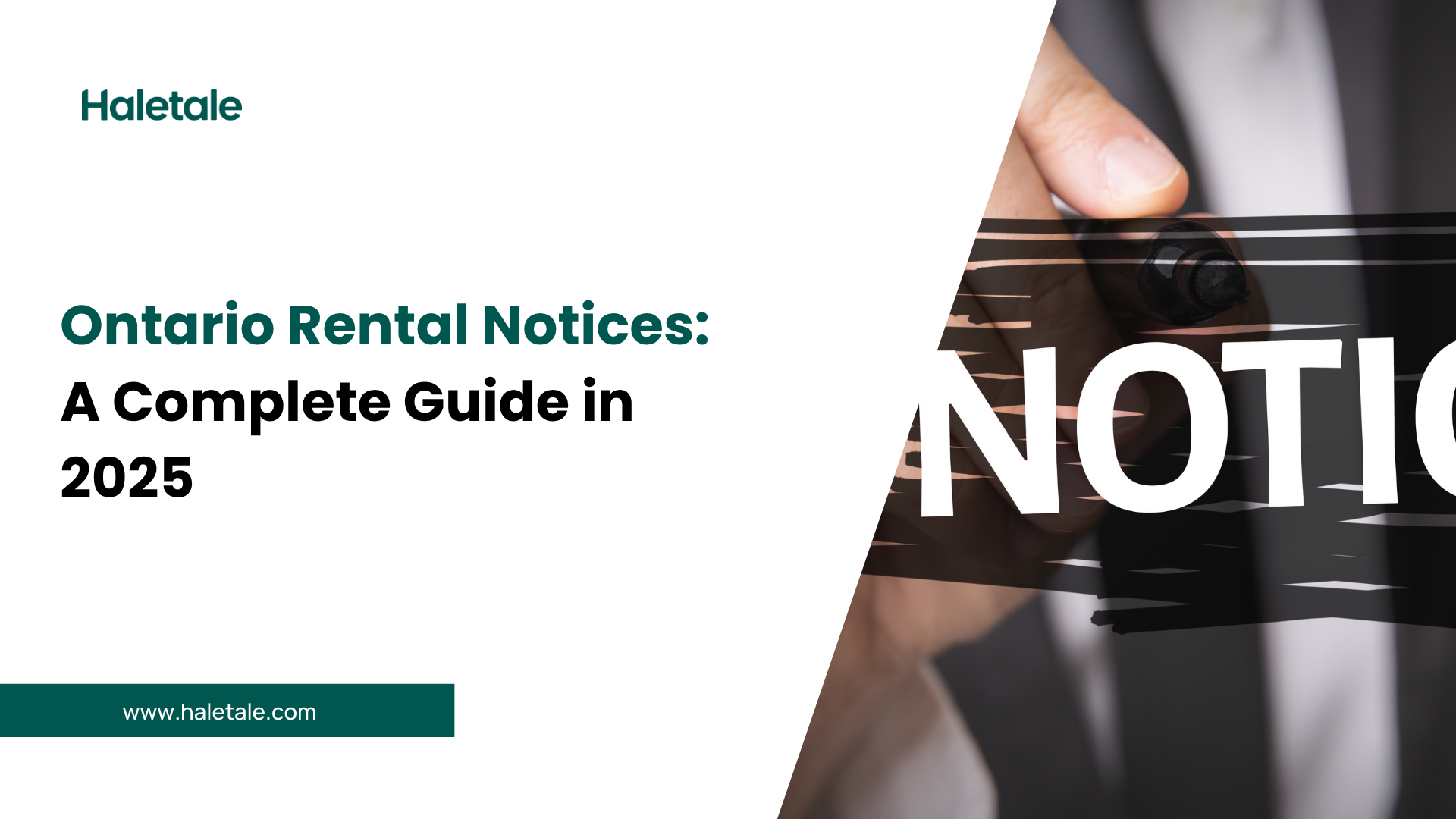The Complete 2025 Guide to ALL Ontario Rental Notices (N1-N13): Mastering Legal Compliance for Property Managers
Ontario rental notices encompass 13 distinct forms that every property manager must master, from the basic N1 rent increase to the complex N13 demolition notice. With 73% of LTB applications facing delays due to improperly prepared notices across all types—not just eviction forms—property managers handling multiple units cannot afford mistakes in any aspect of their legal compliance. This comprehensive guide covers every single Ontario rental notice, ensuring you have the complete toolkit for managing your properties effectively.
Latest Update: September 2025
The Landlord and Tenant Board has updated requirements for all 13 notice types, with new digital filing protocols and revised timelines. This guide reflects all current LTB forms and requirements, including recent changes to rent increase guidelines and termination procedures.
Quick Reference: All 13 Ontario Notices at a Glance
| Notice | Purpose | Notice Period | Can Be Voided? | Filing Fee |
| N1 | Standard rent increase | 90 days | No | None |
| N2 | Rent increase (partially exempt units) | 90 days | No | None |
| N3 | Increase for care services/meals | 90 days | No | None |
| N4 | Non-payment of rent | 14 days | Yes, by paying | $201 (L1) |
| N5 | Interfering, damage, overcrowding | 20/14 days | First only | $201 (L2) |
| N6 | Illegal acts or RGI fraud | 10 days | No | $201 (L2) |
| N7 | Serious safety impairment | 10 days | No | $201 (L2) |
| N8 | End of term eviction | 60 days | No | $201 (L2) |
| N10 | Above-guideline rent increase agreement | N/A | By agreement | Varies |
| N11 | Mutual agreement to end tenancy | By agreement | By agreement | None |
| N12 | Personal/family use | 60 days | No | $201 (L2) |
| N13 | Demolition/conversion/repairs | 120 days | No | $201 (L2) |
Understanding Ontario’s Complete Notice System
The Foundation of Property Management Compliance
Ontario’s 13 rental notices form a comprehensive legal framework that addresses every aspect of the landlord-tenant relationship. From routine rent increases to complex eviction scenarios, these LTB forms provide structured pathways for resolving issues while protecting both parties’ rights under the Residential Tenancies Act.
For modern property management companies, mastering all 13 notices isn’t optional—it’s essential for operational efficiency and legal compliance. Each notice serves a specific purpose with unique requirements, timelines, and consequences for errors.
The Cost of Notice Errors
Recent data from the Landlord and Tenant Board reveals staggering costs associated with notice mistakes:
- Rent Increase Errors (N1-N3): Average $3,200 in lost revenue per unit
- Eviction Notice Mistakes (N4-N8): 8-12 month delays costing $15,000+
- Property Use Errors (N12-N13): Legal penalties up to $50,000
- Administrative Burden: 40+ hours correcting and re-serving notices
Professional property management software eliminates these costly errors through automated compliance checking and form generation.
Rent Increase Notices (N1, N2, N3, N10)
N1: Standard Rent Increase Notice
The N1 Notice of Rent Increase is the most frequently used form in Ontario, affecting over 1.5 million rental units annually. This notice allows landlords to increase rent according to provincial guidelines.
Key N1 Requirements
Eligibility Criteria:
- Unit must be covered under rent control
- 12 months since last increase or tenancy start
- Cannot exceed provincial guideline (2.5% for 2025)
- Must use current LTB form version
90-Day Notice Period: The N1 requires exactly 90 days’ notice before the first rental period when the increase takes effect. Calculation errors here invalidate the entire notice.
Documentation Requirements:
- Current rent amount clearly stated
- New rent amount calculated correctly
- Percentage increase shown
- Effective date properly calculated
Automated rent collection systems can trigger N1 generation at appropriate intervals, ensuring compliance with the 12-month rule and guideline limits.
N2: Rent Increase for Partially Exempt Units
The N2 notice applies to newer buildings where units are partially exempt from rent control—typically those first occupied after November 15, 2018.
When to Use N2 Instead of N1
Applicable Situations:
- Buildings first occupied after November 2018
- Converted non-residential buildings
- Additions to existing buildings
- New basement apartments
No Guideline Limit: Unlike N1, the N2 has no percentage cap, allowing market-rate increases. However, the 90-day notice requirement still applies.
Property management platforms help track which units require N1 versus N2 notices based on occupancy dates.
N3: Notice for Care Services and Meals
The N3 notice addresses increases in charges for care services and meals in retirement homes, care facilities, and similar settings.
Complex N3 Calculations
Components to Consider:
- Base rent increases (guideline applies)
- Care service adjustments (market rates)
- Meal plan modifications
- Medical service changes
Special Requirements:
- Detailed breakdown of each component
- Justification for service increases
- Option for tenants to decline services
- Compliance with care home regulations
Specialized accounting features help track and justify care service cost increases.
N10: Agreement for Above-Guideline Increases
The N10 facilitates mutual agreements for rent increases exceeding provincial guidelines, typically for significant property improvements.
Securing N10 Agreements
Valid Reasons Include:
- Major renovations or improvements
- New amenities or services
- Energy efficiency upgrades
- Accessibility improvements
Requirements for Validity:
- Voluntary tenant agreement
- Clear explanation of improvements
- Benefit to tenant demonstrated
- No coercion or pressure
Document management systems ensure N10 agreements are properly stored and accessible.
Non-Payment Notice (N4)
The N4: Ontario’s Most Critical Notice
The N4 Notice to End Tenancy for Non-payment of Rent remains the cornerstone of rental property management, representing 70% of all LTB applications.
Precision in N4 Preparation
Critical Elements:
- Exact arrears to the penny
- Proper per diem calculations
- NSF fee inclusion (where legal)
- Clear payment instructions
The 14-Day Void Period: During these 14 days, tenants can pay the full amount to void the notice. Automated payment tracking ensures accurate monitoring of the void period.
Strategic N4 Timing
Best Practices:
- Serve on the first day rent is late
- Use fastest legal service method
- Document service immediately
- Prepare L1 application in advance
For portfolio managers, automated N4 generation ensures consistent, timely response to payment defaults across all properties.
Behavioral Violation Notices (N5, N6, N7)
N5: Standard Behavioral Violations
The N5 addresses three categories of violations: interference with reasonable enjoyment, willful or negligent damage, and overcrowding.
The Two-Notice N5 System
First N5 (Voidable):
- 20-day notice period
- 7 days to correct behavior
- Creates 6-month probation
- Detailed incident documentation required
Second N5 (Non-voidable):
- Requires similar violation within 6 months
- 14-day notice period
- Direct path to eviction
- Must reference first N5
Tenant communication portals help document violations and track correction periods.
N6: Illegal Acts and RGI Fraud
The N6 specifically addresses illegal acts in rent-geared-to-income (RGI) housing and serious illegal activities affecting the property.
N6 Unique Applications
RGI Income Misrepresentation:
- False income reporting
- Unreported household members
- Hidden assets or income
- Benefit fraud affecting rent calculation
Illegal Acts (Non-impairment):
- Drug possession (not trafficking)
- Minor criminal activities
- Prostitution-related offenses
- Illegal business operations
10-Day Non-voidable Period: Unlike the N5, tenants cannot correct N6 violations. The 10-day period is absolute.
Specialized RGI management features help track income verification and compliance.
N7: Serious Safety Impairment
The N7 represents the most serious behavioral notice, reserved for conduct that seriously impairs safety or involves significant illegal acts.
High Bar for N7 Usage
Qualifying Conduct:
- Violence or credible threats
- Drug trafficking operations
- Weapons offenses
- Arson or severe property damage
- Gang-related activities
Evidence Requirements:
- Police reports essential
- Multiple witness statements
- Security footage valuable
- Criminal charges helpful
- Safety assessment documentation
Security integration features help compile and organize N7 evidence packages.
Termination Notices (N8, N11)
N8: End of Term Notice
The N8 allows termination at the end of a fixed-term or periodic tenancy for specific reasons, representing a middle ground between behavioral violations and no-fault evictions.
Limited N8 Grounds
Persistent Late Payment:
- Pattern of chronic late payments
- Must document multiple instances
- Not for occasional lateness
- Requires consistent pattern
Conversion to Personal Use:
- Similar to N12 but at term end
- No compensation required
- 60-day notice still applies
- Good faith requirements
Payment tracking systems provide documentation for persistent late payment patterns.
N11: Agreement to End Tenancy
The N11 represents a mutual agreement between landlord and tenant to end the tenancy, avoiding formal eviction proceedings.
Ensuring Valid N11 Agreements
Requirements for Enforceability:
- Truly voluntary agreement
- No coercion or pressure
- Clear termination date
- Both parties sign
- Consideration for tenant
Common N11 Pitfalls:
- Tenant claims duress
- Inadequate consideration
- Unclear terms
- Missing signatures
- Improper inducements
Digital signature integration ensures proper N11 execution and storage.
Property Use Notices (N12, N13)
N12: Personal Use Eviction
The N12 allows landlords to reclaim units for personal or family use, with strict good faith requirements and compensation obligations.
N12 Compensation Requirements
Since September 2021, N12 notices require one month’s rent compensation paid by the termination date. This represents a significant financial consideration for landlords.
Eligible Occupants:
- Landlord personally
- Spouse or partner
- Children or parents
- Care providers
Financial tracking features help manage N12 compensation payments and documentation.
N13: Demolition, Conversion, and Major Repairs
The N13 addresses three scenarios: demolition, conversion to non-residential use, or repairs requiring vacant possession.
N13 Extended Timeline
120-Day Notice Period: The N13 provides the longest notice period, recognizing the significant disruption to tenants.
Demolition Requirements:
- Demolition permits required
- Good faith intention
- Cannot be renovation excuse
- Building actually demolished
Major Repair Criteria:
- Vacant possession necessary
- Building permits required
- Cannot be cosmetic updates
- Safety concerns documented
Conversion Specifications:
- Zoning changes approved
- Commercial conversion planned
- Condo conversion process
- Change of use permits
Project management integration helps coordinate N13 timelines with construction schedules.
Digital Automation for All Notices
Comprehensive Notice Management Systems
Managing 13 different notice types across multiple properties demands sophisticated automation. Modern property management platforms now offer comprehensive notice management covering all Ontario forms.
Automated Compliance Features
Intelligent Form Selection:
- Situation analysis to recommend correct notice
- Eligibility checking for each notice type
- Timeline calculation and tracking
- Deadline reminders and alerts
Error Prevention Systems:
- Mandatory field validation
- Calculation verification
- Date logic checking
- Regulation compliance verification
Cloud-based systems ensure notices always use current LTB forms and requirements.
Integration Across Property Operations
Financial System Integration:
- QuickBooks synchronization for rent calculations
- Automated arrears tracking
- Compensation payment management
- Fee and charge documentation
Communication Platform Integration:
- Tenant portal delivery
- Service confirmation tracking
- Response deadline monitoring
- Document storage and retrieval
Maintenance System Integration:
- Violation documentation
- Repair requirement tracking
- Damage assessment records
- Cost estimate compilation
Analytics and Reporting
Performance Metrics:
- Notice success rates by type
- Average resolution timelines
- Cost impact analysis
- Compliance scoring
Predictive Analytics:
- Payment default prediction
- Violation pattern recognition
- Optimal timing recommendations
- Risk assessment scoring
Advanced analytics platforms transform notice data into actionable insights.
Common Mistakes Across All Notice Types
Universal Notice Errors
1. Using Outdated Forms
The Problem: LTB updates forms regularly; outdated versions are invalid The Solution: Automated systems with real-time form updates The Impact: Complete notice invalidity requiring re-service
2. Incorrect Party Identification
The Problem: Missing tenants, wrong spellings, or corporate name errors The Solution: Integrated tenant management systems with verified data The Impact: Notice deemed not properly served
3. Timeline Calculation Errors
The Problem: Each notice has unique timeline requirements The Solution: Automated calculators considering service method and dates The Impact: 3-6 month delays for re-service
4. Improper Service Methods
The Problem: Using email for notices requiring physical service The Solution: Service method guidance and tracking systems The Impact: Invalid service requiring complete restart
5. Inadequate Documentation
The Problem: Missing supporting evidence or details The Solution: Document management platforms with checklists The Impact: Dismissal at hearing for insufficient evidence
Notice-Specific Pitfalls
Rent Increase Mistakes (N1-N3):
- Calculating from wrong date
- Exceeding guideline amounts
- Missing component breakdowns
- Improper exempt unit classification
Eviction Notice Errors (N4-N8):
- Accepting partial payments
- Vague violation descriptions
- Missing witness statements
- Inadequate safety documentation
Agreement Failures (N10-N11):
- Evidence of coercion
- Unclear terms
- Missing consideration
- Improper execution
Property Use Problems (N12-N13):
- Bad faith accusations
- Missing compensation
- Inadequate permits
- Unrealistic timelines
Complete FAQs for All Ontario Notices
Rent Increase Questions
Q: Can I increase rent by more than 2.5% in 2025?
Only with an N10 agreement, N2 for exempt units, or through an Above Guideline Increase (AGI) application with LTB approval. According to the new laws, ontario rent increase is capped at 2.5% for 2025 and at 2.1% in 2026. You can read more about it here.
Q: Do I need to use N1 for commercial properties?
No, commercial properties aren’t covered by the RTA. Commercial leases govern rent increases.
Q: Can tenants refuse N3 service increases?
Yes, tenants can decline optional care services but must accept base rent increases within guidelines.
Eviction Notice Questions
Q: What’s the difference between N5 and N6 for illegal acts?
N5 covers behavior that interferes with enjoyment; N6 is specifically for illegal acts and RGI fraud, with no void period.
Q: Can I use N7 for any criminal activity?
No, N7 requires serious impairment of safety. Minor crimes typically require N5 or N6.
Q: When should I use N8 versus N4 for late payments?
N4 is for specific arrears; N8 is for patterns of persistent late payment at lease term end.
Agreement and Property Use Questions
Q: Is an N11 better than formal eviction?
N11 can be faster and cheaper but must be truly voluntary. Coerced agreements are unenforceable.
Q: Can a corporation use N12 for personal use?
Generally no, unless converting the entire property to principal residence of a controlling shareholder.
Q: Does N13 require compensation like N12?
No statutory compensation requirement, but tenants may have relocation rights under local bylaws.
Service and Timeline Questions
Q: Can I email notices to tenants?
Only if tenants agree in writing to electronic service. Otherwise, physical service is required.
Q: What if the notice period ends on a holiday?
The deadline extends to the next business day automatically.
Q: Can I serve multiple notices simultaneously?
Yes, different notice types for different issues can be served together.
Digital service tracking ensures proper documentation of all notice deliveries.
Transform Your Notice Management Today
The Complete Notice Automation Solution
Stop risking delays, dismissals, and financial losses from notice errors. Modern property managers are automating all 13 Ontario notice types and achieving remarkable results:
- 82% reduction in notice preparation time
- 94% decrease in technical errors
- 65% faster tribunal processing
- $3,800 average savings per unit annually
Book Your Comprehensive Demo →
Start Your Complete Transformation
Join hundreds of Ontario property managers who’ve mastered all 13 notice types with Haletale:
Full Platform Access Includes:
- Every Ontario notice automated
- Intelligent compliance checking
- Integrated financial tracking
- Complete document management
- Expert support and training
Begin Your Free 14-Day Trial →
Master Every Notice with Confidence
Ontario’s 13 rental notices represent the complete legal framework for property management. From routine N1 rent increases to complex N13 demolition notices, each form serves a critical purpose in maintaining compliant, profitable rental operations.
The complexity of managing all these notices—each with unique requirements, timelines, and pitfalls—demands more than manual processes. Professional property management software that automates all 13 notice types isn’t just convenient; it’s essential for modern property management success.
By understanding every notice type and leveraging comprehensive automation, you protect your investments, maintain cash flow, and avoid the costly delays plaguing 73% of Ontario landlords. Whether you’re serving your first N1 or managing hundreds of notices monthly, the right knowledge and tools ensure compliance and efficiency.
Don’t let notice errors cost you thousands in lost rent and legal fees. Master all 13 Ontario notices, automate your compliance, and focus on growing your portfolio with confidence.
Additional Resources
- Complete LTB Forms Library
- Residential Tenancies Act Full Text
- Ontario Property Management Best Practices
- 2025 Rent Increase Guidelines
Last Updated: September 17, 2025 | All information current as of publication date. Always verify current requirements with the LTB.









